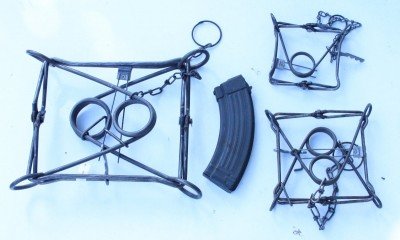
These are three sizes of Conibear, or “killer” traps, with their mainsprings folded in. The one of the left is the 330 size, and the 110 and 160 are on the right, with the AK mag in there for a size reference.
Resources:
Conibear Traps on Ebay
Conibear on Amazon
Trap Setter Tool (in video)
Trapping is always a very sensitive subject. What is the purpose of a trap, whether for a man or animal? I think mostly it is so you can catch something or someone without having to be there. Sure, silence is also an issue. In a survival situation, silence is golden. In the mountains a .22 rimfire will echo for miles, and even in the flatlands, a knowing ear will be able to single it out in a suddenly very quiet, collapsed world. But though you can kill with both a bow and a suppressed firearm, you still have to be there. A trap, a good trap, removes that variable, and either stands guard for you or hunts for you while you are off doing other things.
Why is trapping sensitive for most folks outside of flyover country? Mostly because of the danger of catching something you don’t want to catch in the trap. Then there is the pain factor. When we thing of steel traps especially, we think of leg traps. And yes, the thought of a coyote or possum waiting for you to come and kill it, with its broken leg in a trap, is not very pleasant. So that is why I decided to first explain the “killer trap.” This is an animal trap, not a man trap, and it comes in several sizes, depending on which animal you intend to trap. Also known as the Conibear trap, named after its inventor Frank Conibear in the 1950s, trappers call this trap a “killer trap” because it is designed to snap the neck of the animal. The big 330 size traps go for about $25 each on Ebay, and the smaller ones are about half that.
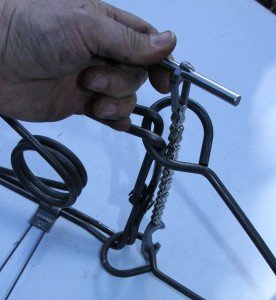
This is the trap setting tool I found on Ebay. For the 330 they are like $25. The video below demonstrates the tool.
A note of caution, one of a few here so please read the whole article, you can’t “practice” with any kind of steel trap while game laws are still being enforced. Trapping is a highly regulated industry, with licenses and seasons and huge rulebooks, and if you try to trap animals illegally you will get caught. If you live in any of the cold states, you’d be surprised to know probably that there are already people trapping the waterways in your area. Most of the felt for high quality hats (think Stetson) come from North American beaver and muskrat pelts. If it weren’t for the trappers still working in America, many of our neighborhoods in rural America would have been flooded out by beavers long ago. Yet if you check out the National Trappers Association website, trapping is one of those industries that is always under attack, not unlike the gun industry.
Many types of animals that are completely illegal to trap now will be subject to trapping in a collapse scenario, even Bambi. And though a 330 Conibear might not be the best way to add some venison to your survival food (I hope to follow this up with other types of traps), it certainly isn’t a bad place to start either. If you look in the pictures, a Conibear has a steel trigger in the middle of it, and it can be driven through an ear of corn, or an apple, or just about anything else that deer regularly eat. The same goes for wild pigs, and having several different sizes of Conibear traps will allow you to try for different sizes of pigs. Breaking the neck of a 350 lb. boar hog with a 330 Conibear is kind of laughable, and I doubt it would even hold him until you get there, but you never know. Setting the large trap low, or even using a smaller trap might help you develop a system for catching perfect sized meat hogs. Nobody wants to eat a boar hog anyway from what I have heard.
The other thing you need to be very aware of with Conibear traps of any size is that they are really really really dangerous. Remember, these are designed to break the neck of an animal, so yes, they might also break your arm if you get it caught in there. In a survival situation, you can’t afford to get hurt, at all. Any injury could turn life threatening, so if you are going to buy some Conibears, you really need to practice setting them. Under the best circumstances you also may not have the strength to actually set a 330. It does require some hand strength and arm strength, and I struggled and got out of breath trying to set my first one.
It looks so easy on the video you see here! I bought his tool available on Ebay, for setting Conibear traps. Compared to the steel tongs that are traditionally used, I thought the physics of this device made a lot more sense. But even if you can use the tool successfully, and get it clipped, you still have to manually pinch the mainspring another inch or so to set the clips built into the trap. OMG is that hard! I almost gave up, then finally figured out where I could pinch with the most leverage to clip it. Mind you, I’m terrified of these traps because I had some years ago and had a small one snap on my hand. It was not pretty, so the 330s scare the heck out of me.
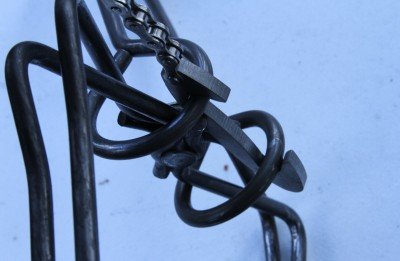
Once you figure out how to anchor the trap with your foot and yank up on the T handle, the tool clips the mainspring.
Eventually I did get it as you can see, and I can repeat the process without getting out of breath now. But fair warning, this is not something you want to do in the field in a survival situation. The traps travel just as well, albeit a little less compact, with both mainsprings set and held by the trap’s clips. I would get your traps to that state at home, then do the final set from there out in the field. Fortunately, once the traps have been clipped the physics are much more in your favor and the last step is really quite easy. you pinch the jaws the last inch or so, set the trigger, and the clips fall away. The trap is now set.
There are a couple other considerations. The first is anchoring the trap. In the pictures you will see what are called disposable anchors. They are a plate connected to a cable, and you drive the plate into the ground about 18″. When you pull back up on the wire, the anchor gets sideways in the hole, and grips solid. Most likely a decent sized hog will tear one out, but not many other animals would, and don’t forget, the goal is the kill the animal when the trap snaps with a Conibear, so it is just as much so that coyotes won’t carry off your animal as it is about holding the animal down. If you expect large hogs, it might be smart to just use a large chain and linkage connected to the trap. Use your better judgement.
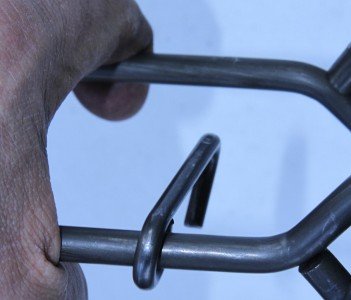
But OMG ouchies! Getting the trap that next inch to grab the built in spring clip is really hard for inexperienced big manly hands.
Another possibly important addition is called a trap stand. If you think about it, other than like the trap on the ground, what can you do with it? I guess you could technically hand it sideways from a tree branch, but it’ll be a bit conspicuous. On the ground the angle is wrong for a deer with an ear of corn, or even a mid-sized hog. You have to get it up off the ground some, and the trap stand allows you to do this, for not a lot of money.
Trapping itself is also not so simple, and this you can actually practice, without including your traps. There is no law against attempting to funnel animals by where a trap would normally be, or using game cameras to see if it worked. You could also use game cameras to tell you where the animals usually walk. Baiting is the same deal. There is no law against nailing an ear of corn to a tree to see if the deer come and eat it with the fresh steel smell on the corn. And on private land, ie. hunting leases, there are no wardens to check if you are practicing your hog trapping skills along with your hog hunting skills. Like anything else, time is always different to put aside. Just remember that most animals have a stronger sense of smell than they do sight or hearing, so even if you are aren’t using lures and baits, cover your own scent as much as possible. If you smell the more popular scent cover sprays at Walmart, they are little more than leaf compost tea, which you can make yourself.
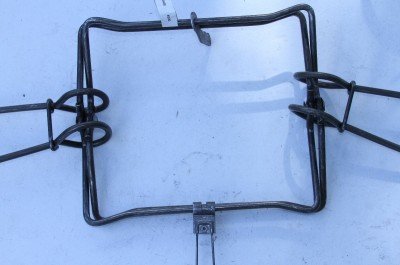
Eventually I got it and did both sides. Once the clips are clipped, the trap is fairly stable and can be transported into the field, read to be set.
Like most topics in this series, my overview here is simply meant to introduce you to a survival resource that you may never have even thought about. I plan to purchase a few different types of snares going forward, and I already did buy some leg traps because for problem coyotes sometimes they are the only thing that works. Man traps are one of the most abused subjects in survival literate. If Rambo traps actually worked it would be great, but tend to be obvious, and just who is it that wants to dig a man sized hole to put sharp sticks in the bottom? Certainly not me! The way I see it, one 330 Conibear and setting tool is going to set you back about $50 including shipping. Check that one off the list.
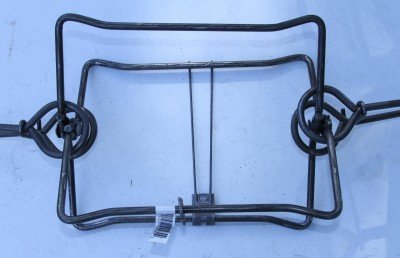
From there leverage is in your favor, since the break point of the mainsprings has already been overcome, it is easy to bring the jaws together to set the trigger.
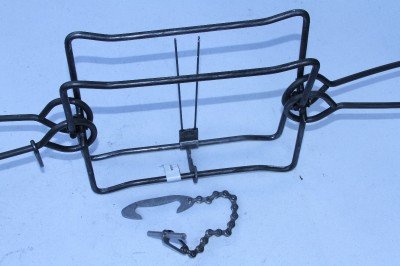
This is the trap set, with the setter tool sitting in front of it to show you how easy it is to carry out to your sets in case you need it, or to reset sprung traps on your next trip.
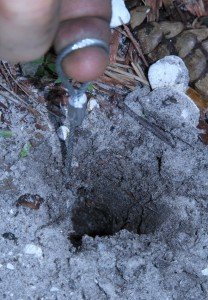
I don’t know if I would trust this to hold a hog that didn’t die in a trap, but it’ll keep a coyote from dragging it away.
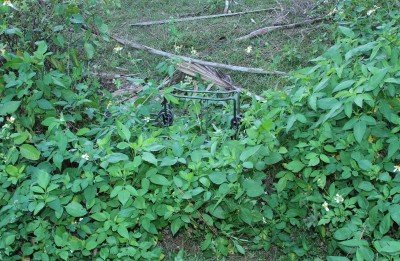
Setting a trap a foot high or so with an ear of corn on the trigger is more likely to be successful than on the ground.

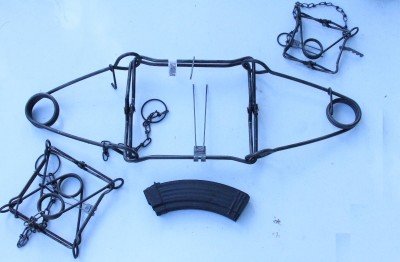
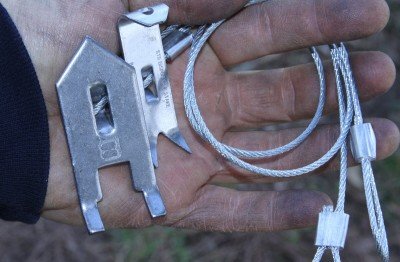
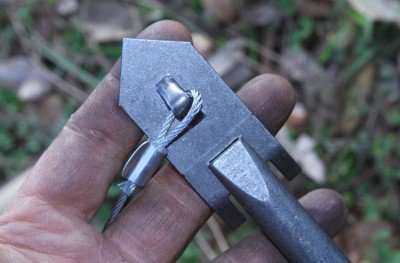
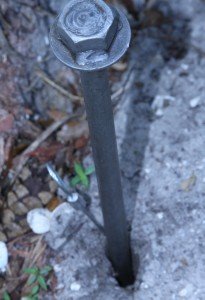
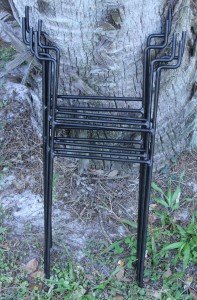
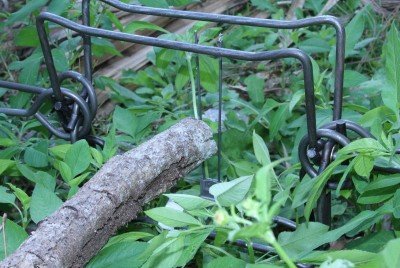
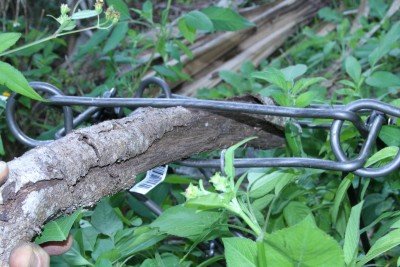
As a kid in the early 70s I ran trap lines of 110s every winter for muskrats. But then expanded to raccoons using leg traps as the area in Ohio where I lived was overrun with them. I switched to using a 110 after seeing them set off a leg trap, common then, then licking the peanut butter off the plate safely. So, I started digging a small square hole about six inches deep and setting a 110 flat framing the hole along with a few small pieces of apples with peanut butter stuck on the trip wires. I put a few more in the hole. Raccoons would come and reach in with their paw and it would trip and it would spring up and grab them high up on the leg and on the paw at the same time. A few times other small game would try to bite it and the trap would snap their neck and kill them. The key was that setting was done where there was clear signs of their presence. I suppose in emergency times, the same could be done with bigger 220s or 330s and could be tested using the horizontal set with a small log to trigger and see if it works the same for larger game. With most deer being smaller and head first feeders, I would presume the effect would be the same. I realize this is not legal, but if there were no alternatives to survival, short of doing the same with a triggered snare, your only option would be using a firearm, which would definitely draw attention.
FYI Trudgin, a “Fir” is a type of tree. “Fur” is what is what is on your cat Fluffy.
trudgin:
Dogs and cats have no business running off-leash in nature they are extremely destructive and in the case of dogs, can become “fera;,” pack up and threaten humans. Domestic cats kill up to 3.7 Billion birds a year! In Wisconsin, it’s actually legal to shoot cats you see out in the woods. I know that people grow very close to their pets–but that’s even more reason to keep your little killer INSIDE where it belongs. And, as others have pointed out, if the SHTF, and your dog or cat end up in one of my traps, it’ll ultimately end up roasting over my fire.
Why not get someone with actual Trapping experience to write an article like this? It’s obvious that the author has no experience trapping. A complete beginner is unlikely to have much success.
Good article. Pretty scared of the conibear trap to.
While I’ve used these traps a lot in the past, I been using the new Dog Proof Coon traps the last 4 yrs with great results. I live on 50 acres surrounded by the Mark Twain Nat Forrest in southern Missouri. While I only have four neighbors within a six mile circle, I do see hikers with dogs, and have had them come onto my property. I’d hate to kill a dog with a killer trap, when a Dog Proof trap works just as good for coons. I use regular spring traps for coyotes and fox, and a dog can be released from them.
traps are a small piece of the pie, but still good skills to familiarize with. thanks for sharing.
Hmmmmm. It’s nice to bring up the subject, but there are several glaring problems here. First, leg hold traps DO NOT BREAK BONES. The critter in a leg hold trap is merely stuck, and can either be released uninjured or dispatched for processing. Second, if you’re crazy enough to try to trap wild pigs with a 330 Conibear, be prepared to lose your trap or have it destroyed. If you want to truly anchor any trap against loss, chain it to a tree or a large drag, like a tree limb. Third, if you nail an ear of corn to a tree, you’ve just bought that tree, because you’ve damaged it. Those of us in the logging business find all kinds of metal hardware stuck in trees from thoughtless fools advocating things like nailing an ear of corn up. Don’t do that. Find a different way to bait your site. Fourth, trapping illegally on private land will get you in just as much hot water with the authorities as will hunting illegally on private land. Illegal trapping is subject to law enforcement no matter where it occurs. And I say this as an experienced trapper: If you are careless enough to begin experimenting with conibear style traps, you’re deserving of whatever injuries you experience. You are likely to hurt animals, too, instead of killing them. What this article failed to pound home is this: If you want to learn to trap, take a trapping course with your state DNR. It’s fun, it’s a good substitute after most hunting seasons end, you MIGHT make enough money selling furs to cover the costs of your traps IF YOU TAKE THE TIME TO PROCESS YOUR FURS CORRECTLY. All of these concerns apply in a survival situation, probably more so.
Has anyone considered that after a SHTF scenario is well underway, any survivors are going to be overrun by feral dogs; once domesticated animals who have turned to packs? What happens when Fifi and Fido begin to starve? The try to eat their former owners. Traps like this would be very important to keep the feral dog population down.
A snare is going to be far more effective controlling feral dogs than a 330 Conibear, which due to the shape of a dog’s head will merely crush its face and snout. Not a death blow at all. Used in waterways and in correctly built land cubbies, where legal, a 330 will cleanly take a beaver or a bobcat.
The feral dog and cat will become nothing more than a game animal along with every other edible animal running wild.
During the great depression most game animals were hunted to the point of disappearing from populated sections of America .
Which is why there are several articles on canning coming up in this series.
I use conibear traps for beaver and armadillo. I live in the ozarks and these animals are worthless pests. The beavers kill large trees by girdling. They also build dams to flood low areas and kill more trees. Armadillos are recent arrivals to this area. They destroy habitat by digging large holes and they destroy ground nesting birds and mammals. The ones lucky enough to evade the traps I kill with a remington 700 .223.
Just curious, what do you bait an armadillo set with ? Or are you just setting on their pathways ?
Iv’e been shooting them with my Armalite survival rifle with .22 long rifle loads and sometimes with #7 bird shot low brass in my Browning auto 12 gauge for twenty years. They are a real pain in the bottom along with the Raccoon’s here in Florida, although the Raccoon’s are easy to trap in live traps.
I set the traps for armadillo by their holes. They dig holes everywhere. I usually set traps by 2 or 3 digs. I use no bait.
I have been trapping for nearly 40 years. Setting a 330 conibear is not that hard with setting tongs. Setting the springs at home and not in the field is very poor advice. The triggers on these traps are sensitive and easy to bump. Sometimes they fire on their own seemingly for no reason. NEVER WAX THESE TRAPS!! If they spring in the field and you set the springs at home first, chances are you will have forgotten your setting tools……then they are hard to set! Even more so if it has sprung onto your arm! I have had it happen, it hurts! As for trying to catch a deer with one, it is not legal. In a survival situation, you could probably do it, but as strong as these traps are, they would not cleanly kill a deer. They spring towards the animal when fired and if it catches a deer far enough back it would strangle it, but it would not have the power to be an instant kill. Better off using a snare, they also would strangle a deer but would be more humane. Unless it is a survival situation, NEVER SET A 330 ON DRY LAND! Chances of killing someone’s pet dog is too great. Us trappers have trouble enough fighting the anti’s without that. Even worse what if you catch a kid? Remember, these traps are designed to kill! Think about what you are doing, and where you are setting these. They are some of the best traps out there for beaver, I have caught up to 70 pound beavers with them.
Not a bad article overall, but I do take strong issue with the description in the second paragraph about traps breaking animal’s legs. We try very hard to prevent that. Here, the author called the trap a “leg trap”. Properly set, it’s a foot hold trap, because that’s where we want it to catch. If an animal breaks it’s leg, it can “wring off”, which results in losing the critter, and the critter dying late of agony. Neither is a good outcome. So the usual solution is to use a smaller trap, so the traps jaws close on the foot, not the leg.
I should also point out that swivels on the trap and trap chain are important to prevent injury to the critter.
The comment from david is correct and rather than being so defensive, you should acknowledge it and just move on. As you say, you’re inexperienced. There’s a great video on Facebook by Donnie Leonard showing him catching his hand in a new double spring #550 leg hold trap that is much larger than most people would use even for coyotes. Most states require that leg hold traps use padded jaws or offset jaws and all they do is hold an animal tight. They certainly won’t snap the bone of an animal as they just don’t close that tight. You’re absolutely right about the Conibears, they can be dangerous! Practice setting them is definitely warranted. I would hope you’re not so sensitive that you have to respond to this note as you did David’s. But it doesn’t do any of us who like to hunt and trap to fuel the fire of the anti’s with inaccurate information. Thanks for the article.
Sure would like to see one for juvenile delinquents….. legal of course.
Trapping for furs is only one aspect of trapping. It will be outdated when agriculture, product contamination, domestic tranquility is.
every body can say want ever about trapping ,my fam has done it for years .just know this when out of a job an your fam needs come first ,trapping helps out with food an xtra money …thats that.
Trapping is a out dated ….People other that those using a mouse trap in the house should have them deposit up their asses …. I know personally of several dogs and cats that have lost their legs and lives from the want to be trapper setting where he has no business using a trap… Most trappers are good at checking their traps daily but there are those that figure once a week is enough. If you want a trapping permit I suggest that you set for 24 hours with your nuts in one when it it below 0 and enjoy your pain, if you still think you should be a trapper go for it…. Firs have long sense been replaced and are no longer needed for top hats…. give it a rest and take your traps to a welder and have him weld them up for you and hang them on the wall and tell tall tails about your days with Jim Bridger and the boys ……
Cool! Want to go trapping?
Sorry you think trapping is outdated, Trudg. It’s actually the only tool available to control furbearer’s numbers. Yes, there are some slob trappers out there, just as there are slob hunters, fishermen, and so on. But the very large majority of us respect the animals we trap, and we respect the laws governing our activity.
You don’t know what you are talking about. The fur trade is alive and well. The rest of the world is not as squemish as the folks here in the USA. There are still a lot of us trappers out there that rely on trapping for a good share of our income.
I will verify your comment next time I buy a Fir hat!
Very well said, Sir
Zip it hippy.
Thanks for what I thought was a well written, informative article. I am not a trapper (yet). Just too many other hobbies such as re traditional target shooting, gun hunting, and reloading to keep me busy.
The one stand out thing I got out of the article was that a novice trapper should probably not start with Conibear style traps. (Unless they have a knowledgeable trapper assisting them and showing them the ropes). Conibear’s seem to be very unforgiving if you accidentally trip one on an appendage.
When we were kids we used to have contests on who could trip the mouse trap with our fingers and not get smacked for our efforts.
This progressed to large rat traps and I can tell you from experience those things HURT big time, and sometimes you get a finger fracture.
All I can say is thank the powers of the universe we didn’t have any of those Conibears lying around…
Your opening comment about having an animal “wait in a foothold with a broken leg” is pure Bullshit !! I have trapped all my life and have NEVER had an animal that could not be released from a foothold safely,, This mis-informed article writer maybe should take to the field before they regurgitate false rumors across the internet..
The whole point is that you are killing the animal hello. We aren’t talking about puppies here. The anti-trappers use the vision of a fox caught in a leg trap trying to chew his leg off to pull at the heartstrings of the fools who live on the coasts of this once great country. Of course self righteous fools like you aren’t much better.
Foothold traps are actually created to specifically not break the bone, because if the bone is broken it is very easy for the animal to just tear his own foot off. The point was that it is perceived as such.
I’ve used these traps for 30+ years, very successfully. I’ve placed them in creeks for muskrat & ended up getting fish & ducks . I’ve set them for groundhogs, coons. What we always did was take some black mushy hulls of walnuts & boiled them, placed the traps in the boiling water for 1/2 hour to reduce the shine on the traps. Remove the traps & hang to dry, throw in some decaying leaves , pine needles & smashed acorns to boil some more. Anything from your local forest to make a cover scent. put it in a clean unscented spray bottle. Excellent for deer season hunting also. When you check your traps you’ll never end up with just a foot. They are correct about watch your fingers, they are very unforgiving traps.
Tongs are FAR safer and more efficient in setting Conibears. The picture of the man’s hand setting the safety clip is misleadingly dangerous. No need for anything like that with tongs.
Good article. Recommend you do one on improvised snares. Traps are to heavy when on the movewhile afoot.